Theodore - Crawling Through a Keyhole
Maurice Rooklyn (1905 – 1992) was one of Australia’s foremost magicians, known primarily for his Billiards manipulation act, and illusion shows such as ‘Pink Champagne’ and ‘Blue Velvet’. During a versatile performing career he also featured as a hypnotist, mentalist, juggler and ventriloquist.
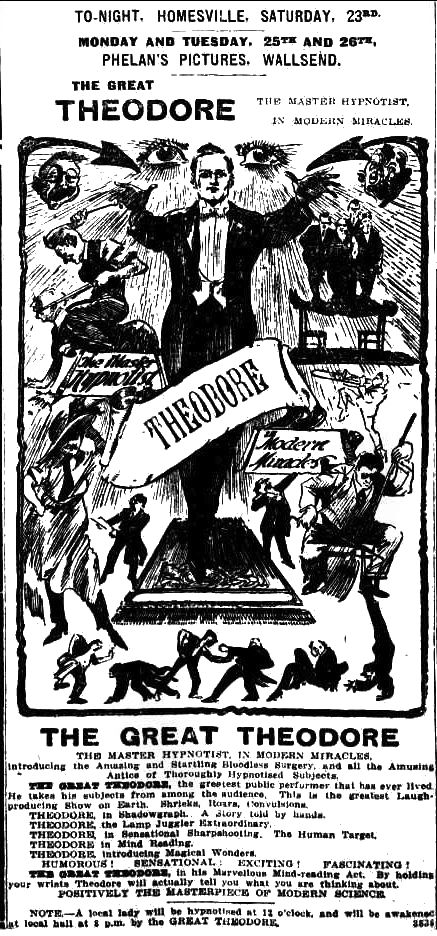
April 23, 1921, Newcastle
In another story we tell of Rooklyn's time as “The Human Target” during the Depression, and reference is made to his early years working for a performer known as “Theodore”. There is almost no information in the published history of magicians concerning Theodore, and while this document has many gaps yet to be filled, it shines a light on a versatile and enduring performer over the early twentieth century.
In Rooklyn’s self-published reminiscences, “Spherical Sorcery and Recollections of a ‘Pro” (1) he tells of his experiences travelling as a developing and ambitious young performer, around sixteen years of age:-
“Finishing with the Melfield Costume Comedy Company, I joined up with a most versatile performer named Theodore, whose show comprised hypnotism, juggling, sharp-shooting and a contortion act in which he featured “Crawling Through a Keyhole’. Theodore was a tall, lean, kindly man with a florid complexion, a luxurious mop of red hair, a most commanding personality, and a voice to match; it would resound through the walls of the theatres. Prior to our association, Theodore had always been a “loner”. It was now a one-and-a-half man show. My first task on the job was to stand at the front door and take tickets. Theodore was much smarter than I, he sold the tickets. At eight o’clock I would run around backstage and, with the curtains still closed, play an overture on the piano. (I have often wondered how I was able to do this and still come out of the theatres alive. The quality of my musicianship was such that any act that followed me was assured of an excellent reception).
My next job was to open the curtains for Theodore’s entrance, an entrance which he made most majestically, walking to the footlights (if any) and delivering a speech which was tantamount to informing the audience how fortunate they were to be in the theatre. Being young and highly impressionable I would listen eagerly to his every word, believing everything he said; to me he was a genius. Theodore would then perform his juggling act which was quite good, and I would concentrate on his every move, as at that time I was practicing juggling and, by studying him, gained many hints to improve my own work.
After Theodore’s final trick (the three billiards cues), I would enter with a doll and perform my ventriloquist routine. Theodore followed this with his sharpshooting act, which entailed some trick shots, including the shooting up of a number of large resin targets affixed to the head, shoulders and waist of an assistant. He followed this with the shooting of a bullet through the assistant’s body, the bullet smashing a sheet of glass held in a stand at the back of the assistant. The handbills referred to the assistant as “Eileen, the Bullet-Proof Lady”. I was Eileen.
At the conclusion of that effect I would walk off stage while Theodore further demonstrated his ability with a rifle. I would then clear my hair and suit of particles of resin and broken glass and get ready for my magic act which closed the first half of the programme. The interval was spent counting the takings.
The second half of the show was taken up with Theodore as a hypnotist. In requesting volunteers to come on stage to act as subjects, Theodore always stressed in his address that “neither fools nor drunkards could be hypnotised”.
This was rather a smart move on Theodore’s part, for no volunteer, after listening to Theodore’s hypnotic suggestions, had the courage to leave the stage unhypnotised without branding himself as either a fool or a drunkard. He was forced to co-operate. I was the stage assistant.
During the time we had been together, we had many times discussed what we could do in an emergency, what to do for “outs”. It was just as well, as we had need of an “out” at a later date. I recall playing the coalfields of New South Wales and appearing to a half-full house at the town of Cessnock. After Theodore had invited members of the audience to come on stage and be hypnotised, we heard a loud-mouth say “He won’t hypnotise me, I’ll show him”, etc., etc. Theodore glanced at me. I got the “message” and walked off-stage.
When the loud-mouth came on to the stage, Theodore stood him about four feet in front of the backcloth, so that he faced the audience. Facing the man, Theodore, with his resonant, commanding voice (a voice that invariably scared the daylights out of me), said, “You will now go into a deep, deep, sleep. You will find yourself in a beautiful garden. You will be completely surrounded with flowers and trees, and be overcome with exotic perfumes”, and so on. As Theodore was speaking he continually pushed his fingers at the eyes of his quarry, forcing him to retreat against the backcloth, where I, from behind, could see his shadow. I stuck him with a hatpin. The loud-mouth let out a roar, Theodore raised his arms high, then bringing his right arm down, he pointed a finger at his victim and, with a voice like thunder, cried, “You have been stung by a bee!” The audience was in an uproar of delight as Theodore (an old hand at the game) bustled the young man from the stage.
By this time I was able to do a juggling act, which I later incorporated with magic and ventriloquism. I later dropped this and concentrated on ventriloquism, at which I made a living for some years. Australia, in those days, had a population of only seven million, and performers had constantly to change their acts to keep in work. Through the years I performed four different ventriloquial acts, a juggling act, many different magic acts, hypnotism, mental acts and finally illusions.’”
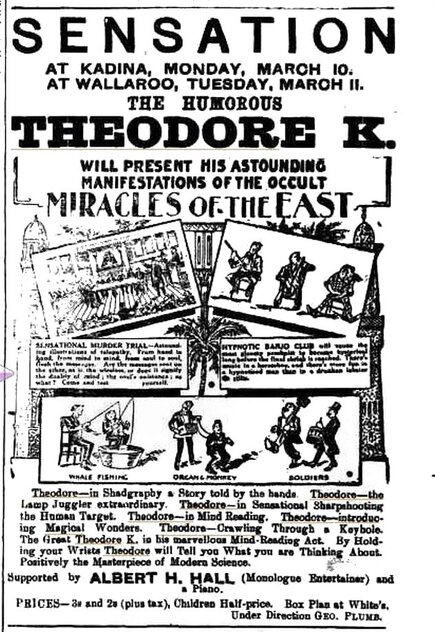
March 8, 1924
Rooklyn’s memories give the best available insight to the personality of Theodore; but who was he, and what was his status as an Australian performer? Sadly there is presently no photograph that I can locate, and little personal information to tell his age or family background. In this document we begin the search by locating the public newspaper records of his activities.
Theodore was not principally a magician. Amongst an array of talents, his specialties were juggling, hypnosis, sharp-shooting and contortion. He travelled throughout Australia and New Zealand over a period of some forty-six years from around 1906. He played in every conceivable venue from small town halls to the best Variety theatres in Australian capital cities. We find, from a limited number of news reports, that his name was Theodore Krause (2) and he was born about 1890. A single advertisement refers to being “Managed by T.Krause of Chicago”. Early billing (c.1908) presents him as “Herr Theodore”, implying a German connection, but beyond this we have no supporting evidence as yet.
Theodore appears in the press as early as January 6, 1906 in Melbourne, billed as “Theodore, second sight Juggler Unique” and shortly afterwards in Launceston (Tasmania) with the Frivolity Entertainers as “Theodore, Australia’s Marvellous Juggler” or “Australia’s Greatest Juggler”. Reviews say he juggled blindfolded. By February 1907 at the Brisbane Tivoli Gardens his advertising was for “The Wonderful Theodores, introducing their sensational Chandelier Juggling Act.” Occasionally in later years there were references to various comic assistants to his juggling act or the “Shooting Through a Woman” routine, but on the whole it seems that Theodore worked alone or with a very small company, none of whom received mentions by name. In June 1908 Theodore was in Western Australia with Fitzgerald’ Circus as “The great Eccentric Juggler”.
Theodore, as a young man, is mentioned in 1910 in shows associated with a magician, “Prof. Merle”. This would be Don G. Merle, whose life is detailed in “Magical Reminiscences” by Harrie Ensor (3). As Merle was himself only twenty-four, born in 1886, it may be that the pair had struck up a friendship and were working to build up their reputations. Theodore is billed in 1910 as “The tired juggler and conjurer”, in reference to a “lazy juggler” theme while dressed as a clown; but references to conjuring do not reappear until later. By 1913 the juggling act was themed as a “Messenger Boy”. His act has echoes of the great Paul Cinquevalli (1859-1918), who starred in Australia in 1899, 1903, 1909 and 1914, and whose juggling and balancing was notable for the unusual, and heavy, objects that were balanced.
Between February and April, 1911, Theodore journeyed to New Zealand, appearing around the Otago region and Auckland with both juggling and a shadowgraphy act; he would return to New Zealand between February – May, 1920.
Newspaper reviews, when not obviously re-hashing the promotional text provided by the performer, were always complimentary to Theodore’s act, both his skill and the entertainment value of his performance:
The Telegraph (Brisbane, Queensland) May 22, 1911 – [Empire Theatre, on the Fuller circuit] "Theodore was seen for the first time; he is an expert in juggling and balancing. Theodore’s first feat was to unhook a three-light chandelier, hanging from the flies of the stage, and balance it on his chin, juggling with balls and Indian clubs meanwhile. The brass rod of the chandelier is then lowered, and on this rod Theodore, with one foot in a loop, spread out in horizontal position, does some sensational juggling. Some clever balancing was also done with a billiard cue and balls. The mute comedy of Theodore’s assistant was very amusing."
Of note is that Theodore shared the bill during this successful week of shows with manipulator Nate Leipzig - “Leipzig's facile fingers again manipulated a pack of cards with amazing dexterity; his tricks were all new, and included magnetism of the fingers with cards and a knife, he made selected cards spring out of the pack, and as an encore made what he called a silver collection. "No need to work when you can do this," was his comment. Illustrating how it is done, an enlarged hand is thrown upon the white screen, by the Vitagraph instrument, where the coin is seen travelling over and round the fingers in bewildering fashion".
Up to this point, Theodore’s principal claim to fame was his juggling, but gradually other talents come to the fore, developing over the years to incorporate a wide repertoire of Variety Theatre skills. Between 1913 and 1915, Theodore could be seen on the same bill as both “The Great Salvo” (magician) and ‘His own double, Theodore’ (juggler). As always, he continued to make loose alliances with Variety companies, agricultural shows and circuses, wherever he could present his act, in School of Arts buildings or on the quality circuits.
In October 1914 Theodore found himself in strife with the law. At Forbes, New South Wales, he had been operating a device called the “racehorse game” in which five or six metal horses, attached by a cord to an eccentric roller underneath the table, ran a ‘race’ as each the bettor turned a handle. In his defence in court, Theodore Krause said “I am a theatrical man, and am a juggler, magician, and sharp shooter …. I say it is a game of skill, because each man turns his own handle … no player has any advantage so far as the working of the machine is concerned.” The Police Magistrate disagreed, however, and Krause received a fine.
During 1916 there is little mention of Theodore in newspaper advertisements, but he soon resurfaces in April 1917:
Bendigo Advertiser (Victoria) April 10, 1917 - [Reviewing side-shows at the Bendigo Easter Show] The Theodore Novelty Show provided a somewhat diversified and attractive programme, consisting of sharpshooting (cutting the dress off a lady with bullets), juggling upside-down, clever conjuring, introducing the Chinese rice bowls, (perch) and shadowgraphy acts. The show is under direction of T.Krause of Chicago, U.S.A.
“The Human Target” and “The Bullet-Proof Girl”
In our story of Maurice Rooklyn and his time as “The Human Target”, we see an act in which Rooklyn apparently caught a rifle bullet between his teeth. This was a magician’s feat, one which has infamously killed a number of performers. Looking back to Theodore, it is important to distinguish several unrelated stunts which were billed variously as “The Human Target”, “The Bullet-Proof Girl” and “Shooting Through a Woman”.
The Human Target, as performed by Theodore, was a sharp-shooting stunt. He fired one rifle at the trigger of a second rifle, which then discharged to return a bullet aimed at a point barely above Theodore’s head.
The Bullet-Proof Girl, or Shooting Through a Woman, was featured as early as 1922 and was being strongly promoted in 1929. It was effectively a magician’s trick staged as a sharp-shooting feat. Theodore would permit audience members to bring their own rifle and bullets. He fired the gun at “Eileen” the bullet-proof girl, the bullet passing through four playing cards, smashing a saucer held against her chest, and shattering a mirror directly behind her. In Rooklyn’s memoir he comments “I was Eileen”, indicating that Theodore would use whichever assistant he might be employing at the time (and not that Rooklyn was attired as a woman!).
Another of Theodore’s signature routines, and one which he was still performing until close to his death, was “Crawling Through a Keyhole”. Descriptions of the act say that a 6 x 10inch keyhole cut into an aluminium plate was used, and that the performer contorted his body to climb through the hole. Already a tall man, Theodore supposedly “grew by 6 inches” during the performance, ostensibly because he dislocated limbs to get through; though this smacks of hyperbole.
In 1924 he included juggling with a lighted kerosene lamp which was balanced on three straws on his face. In December 1925 we see him advertising as the “Theodore K. Novelty Company” at Coffs Harbour, New South Wales.
By 1926, his repertoire included juggling, ventriloquism, sharp-shooting, hypnosis, shadowgraphy, lightning sketches, contact mindreading (finding a hidden item while holding the wrist of a volunteer who knew the item’s location), and the Keyhole act.
As well, there are references to performances of magic tricks such as the Chinese Rice Bowls, and the Magic Kettle (pouring multiple types of drinks from a tea kettle). In 1922 he joined the ranks of many others presenting the newly-created “Sawing a Woman in Half” illusion. Around 1935 Theodore had added “escapologist” to the list of his talents, incorporating an escape from a sealed packing case, and a straitjacket escape.
Advocate for the Northern Coast Districts (Taree, New South Wales) January 23, 1926 - "The popularity of Theodore K. as an entertainer was proved by a bigger house on Wednesday night than on Monday. The audience, too, applauded liberally, showing their appreciation of two good shows in one, for less than is charged by travelling companies for one. The pictures were also first-class. Theodore added ventriloquism and some different tricks to his programme. He also did some expert juggling with fire. His balancing feats were wonderful. A heavy tub is set spinning on the leg of a chair which also spins round while the whole is balanced on his chin. Another very fine feat is the balancing of four ordinary chairs and a table on his chin. The weight alone, in this case, is enough for a man to [hold]. The hypnotic subjects had the audience in tears of laughter all the time and everyone marvelled at the ease with which Theodore K. got through the keyhole."
Without attempting to list every place that Theodore played, it is evident that he was a motivated and active Variety artist, certainly with a high opinion of himself (advertised, in 1921, as “the greatest public performer that has ever lived”). In an advertisement at Newcastle on August 23, 1922, he states with probable honesty that he had been engaged at various times by Harry Rickards, Ben J. Fuller, J.C. Bain, Harry Clay, Ted Holland etc – in other words, he had worked for all the major Variety promoters in the country.
His career continued along these same lines for many more years, as the theatrical scene changed in the face of encroaching competition from moving pictures. In 1935 he was appearing alongside movie features, and in 1942 he was travelling with Thorpe McConville’s Wild Australia Rodeo Circus, still with juggling, magic and the Keyhole act.
As late as November 15, 1950 (at Glen Innes), Theodore was still working with escapes and the Keyhole. However, on July 26, 1951, the day after his death, a simple announcement in the Sydney Morning Herald notified that the funeral of the late Theodore Krause, of Darlinghurst (Sydney) would take place at the Independent section of Rookwood Cemetery, L_Zone F/#/1449. Online grave records for Rookwood reveal that his age was 61.
A formal announcement in the Herald on October 12 indicates that Theodore Krause had died intestate.
“Magic Makers”, the newsletter of the Australian Society of Magicians, noted, “Many Australian magicians will remember the Great Theodore, who played almost every theatre in Australia. He passed on to the Great Magician during July. He was well known for this original version of "Crawling Through a Keyhole." Many Sydney magicians learned their first tricks from him.”
It seems a pity that a multi-faceted entertainer such as Theodore, who worked throughout Australia over nearly half a century, should be lost to history. This story is lacking some of the most important details, which would describe his personality, family connections, and origins. However it may serve to lend some deserved recognition to a hard-working and capable entertainer of the Australian Variety scene.
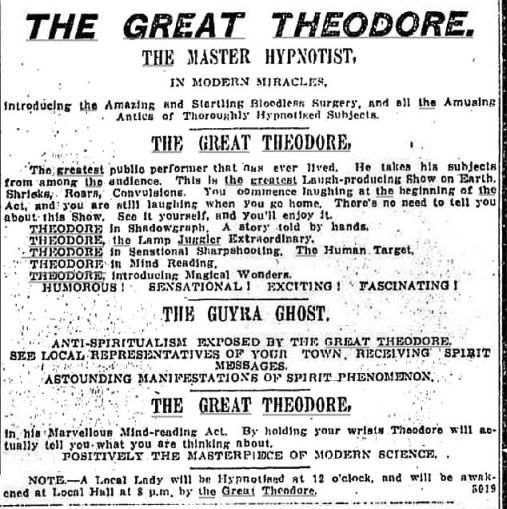
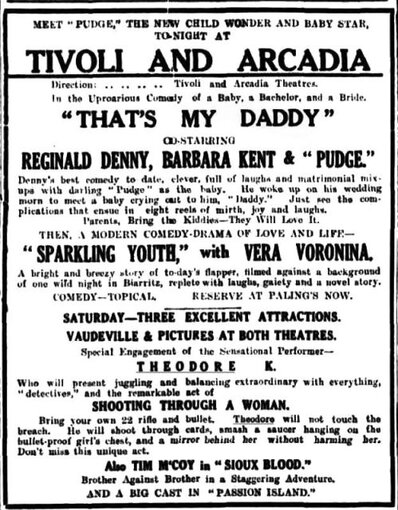
May 2, 1921,Newcastle - October 9, 1928, Rockhampton
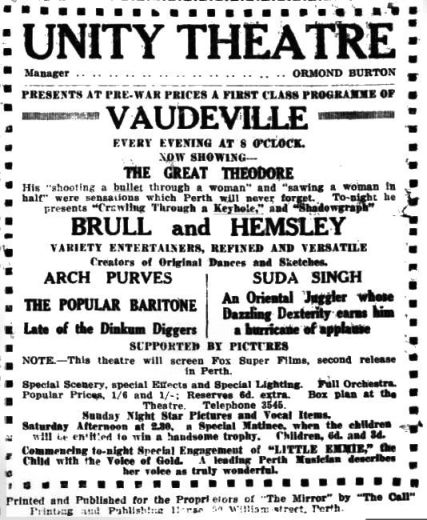
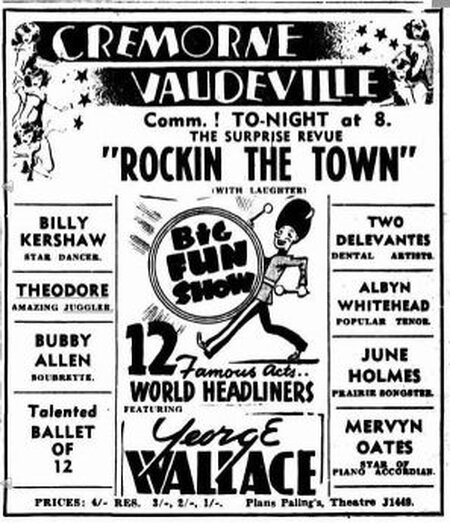
September 29, 1923, Perth - September 8, 1941, Brisbane
REFERENCES
(1) Excerpt from “Spherical Sorcery and Recollections of a ‘Pro” published 1973 by Emmar Investments P/Ltd, Sydney. Before taking up this part of the story, Rooklyn makes reference to being around sixteen, so if the chronology is correct it would be about 1921+ or later. Newspaper advertisements for the town of Cessnock, mentioned by Rooklyn, show that Theodore played there, or in nearby Hunter Valley towns, in 1907, 1911, 1918, 1920, 1921 and 1926.
(2) Based on a court report from Forbes Times of October 2, 1914 (accused calls himself a juggler, sharpshooter, magician), a news report in Perth Daily News ( September 5, 1944) and on the 1951 death notices.
(3) “Magical Reminiscences” by Harrie Ensor, originally published as a series of articles in the Sydney magic magazine, “The Imp”, 1945-1951 and privately republished in book form by Brian McCullagh, 2004 as “Magical Reminiscences”. Don Merle (George Henry Peter Armstrong, of Ararat, Victoria) was born on November 18, 1886 and was performing in Melbourne from 1905. He travelled to New Zealand in 1906 and, during the war years up to the early 1920s, through the Dutch East Indies, Spain and India. Sadly addicted to alcohol, he hung himself at his Ararat home on July 13, 1946.